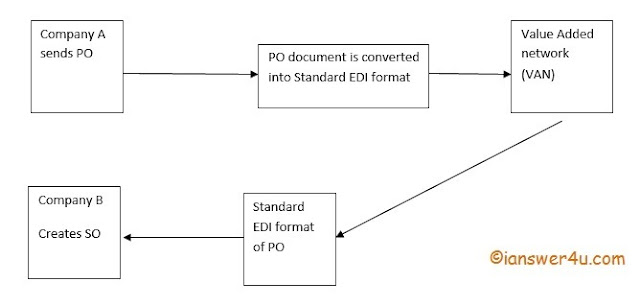EDI Definition
EDI stands for Electronic Data Interchange. EDI is an exchange of data or business documents between two or more businesses using a standardized electronic format, without human intervention. It is mostly used by large businesses to carry out their business process over a secured network with accuracy and in less time.Below are some examples of common business transactions/documents which are often shared by different companies.
1) Purchase order (PO)
2) Sales order(SO)
3) Invoice
4) Advance Ship Notice (ASN)
5) Functional Acknowledgement
Each company has their own format of sending these documents. Suppose we have two companies A and B. Company A sends its purchase order (PO) to company B. As the format of the document is different for the Company B, it will manually read the data from PO sent by Company A and creates a Sales order (SO) from it in order to carry out further processes. EDI provides the data exchange formats and reduces the manual intervention in the process.
Let us understand how electronic data interchange works with help of a diagram
 |
| Working of EDI process |
By using EDI, we can provide speed and accuracy to the information being sent from one business to another. In EDI enabled systems, everything is fully automated with less human intervention.
Moreover, in the given example, EDI system allows Company A to select the vendors, plan the production schedules electronically and create purchase order (PO) automatically. The errors involved here are minimal as there is less human involvement. When the PO reached at Company B end, the EDI helps to create Sales order (SO) automatically without any human involvement of creating Sales Order from PO send by Company A.
Standardized EDI format
Below are some of the examples of EDI standard format used by different organizations-
1) UN/EDIFACT standard
It is basically used for administration, Commerce and Transport. It is developed under UNITED NATIONS (UN) in 1987.
2) ANSI ASC X12
It is used by health care, insurance, government and transportation. It is chartered American National Standards Institute (ANSI) in 1979.
3) GS1 EDI
It is used by Supply chain process for carrying out processes like Order, Dispatch Advice (Shipping Notice), Invoice, Transport Instruction, etc.
4) TRADACOMS
It is used by UK retail sector. It contains transaction like Product information file, Price information file, the customer Information file, the order file and many more operations.
5) HL7
It provides standard format for exchange of information related with retrieval of electronic health information.
Let us now look at various advantages and disadvantages of Electronic Data Interchange.
Benefits of EDI
1) Expedite transmissionInformation is transmitted from one organization to another organization efficiently and swiftly.
2) Automated Data entry
Data is entered automatically by EDI software. For instance, when purchase order (PO) from one company is received by another company. Sales order (SO) is automatically generated at other company’s system with the help of EDI software.
3) Receipt verification
Receipt verification can easily be done with help of EDI software. No human intervention is involved so there are minimal chances of error or delay.
4) Data Validation
Data validation is automatically done.
5) Availability of free software
Free softwares are available depending upon the EDI format chosen. For example- In TRADACOMS EDI format, Price Information file and order files are available for free.
6) Low cost
Lower administrative, resource and maintenance cost.
7) Faster processing
With the help of EDI, business processes can be executed at a much faster rate as compared to the traditional method sending information.
8) Building long-term relationships
EDI helps in building long term relationships with trading partners and hence helps in business growth.
9) Reduction in error
EDI has discarded manual data entry and paperwork. So there are minimal chances of error.
Drawbacks of EDI
1) ExpensiveSetup and maintenance of some of the formats of EDI is expensive.
2) Initial setup is time consuming
Initial cost to setup EDI is time consuming.
3) EDI standard changes
The business process depends on EDI standard format. If any of the standard format changes then the business process has to be changed accordingly.
4) System electronic protection
An EDI enabled system needs electronic protection from viruses, hacking, malware and other frauds.
5) Staff training cost
Staff needs training in order to run EDI enabled software. Investment has to be done in training.
6) Proper backup should be maintained as the whole data depends on EDI. In case of any crash of EDI system, proper backup has to be maintained and extra cost is required for it.
7) Limit your trading partners
Some organization stops doing business which don’t use EDI. For instance, Wal-Mart prefers to do business only with those organization which uses EDI.
What is the market scenario for EDI and its competition?
The demand of EDI is very high. Businesses are actually rejecting other business as they don’t use EDI. Trading partners are offering discount if they get converted into EDI.Since EDI contains both data and data schema in the same file. It is simpler for the programmer to provide EDI solutions. EDI implementation is simpler for any organization as it is faster and leads to lower cost.
EDI has been proven to be reliable, affordable and easy to use amongst all types of businesses. It is the best source for creating business relations with other businesses.
Electronic Interchange started with food and cars industries and it was successful. Then in 1996, the medical industry started using EDI for its application and after that it became popular. EDI has a good scope for the future and fulfills all the needs of the customer. EDI businesses and tools will evolve for smart devices and will always be demanding.
You may also like read :
Beginner's Guide to insurance
Shocking Myths about Credit Cards
Earned Value Management Terms and Formulas
Copyright © ianswer4u.com



0 Reactions:
Post a Comment